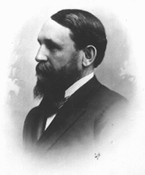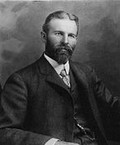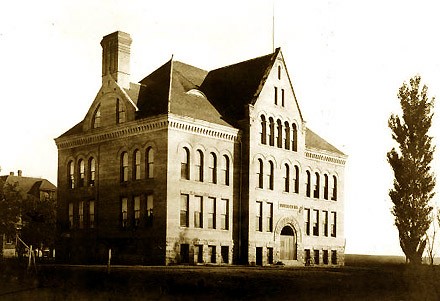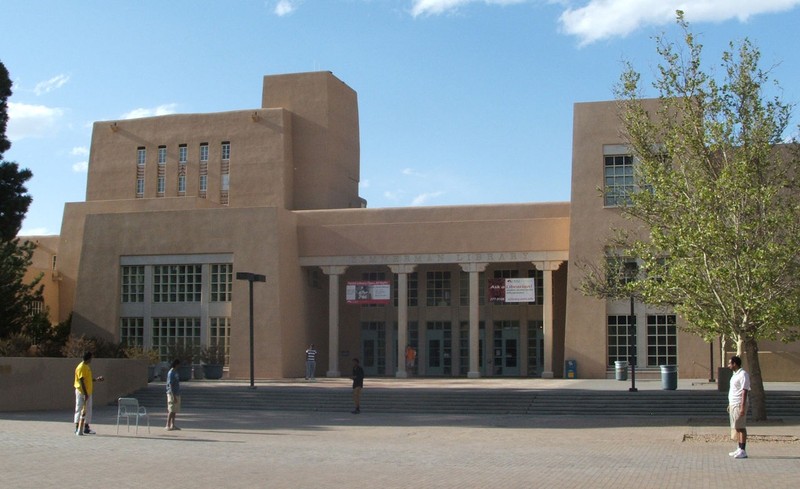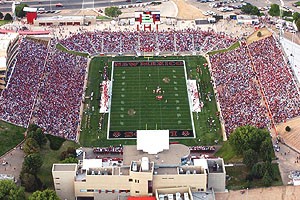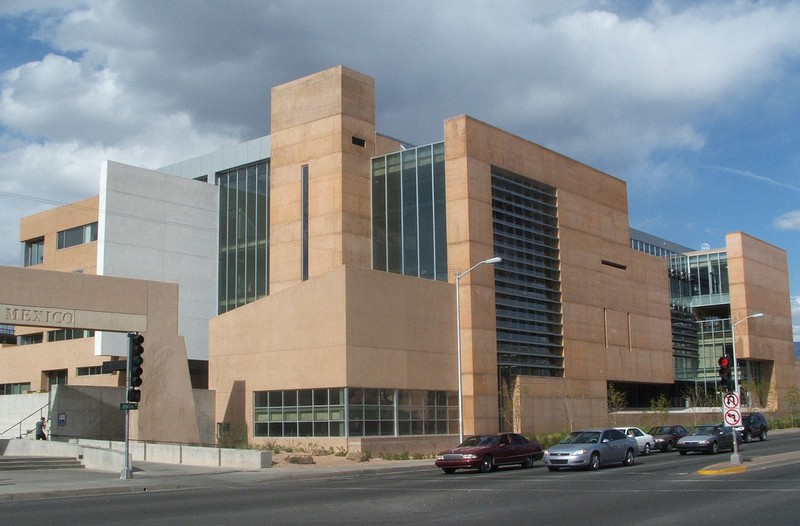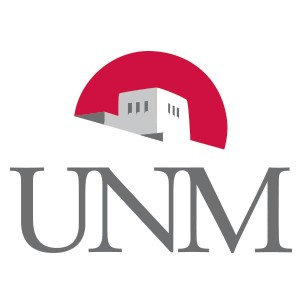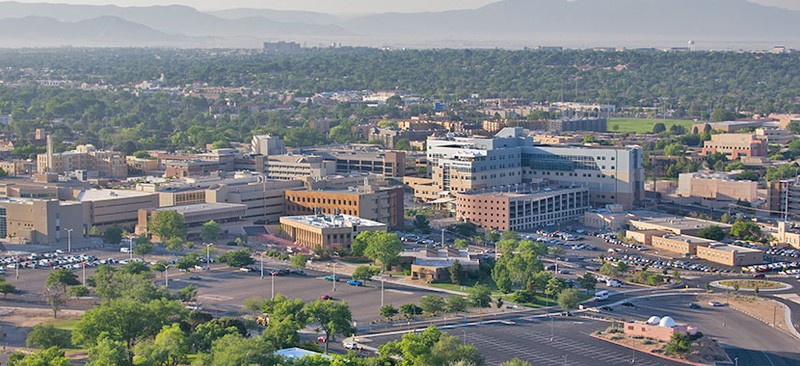The University of New Mexico is one of the state's oldest post-secondary institutions. Today, it is the largest employer of the state, the state's largest post-secondary institution, and the state's flagship institution when it comes to research. Steadily growing since its inception, it would be after WW2 that the university would see significant growth and receive many awards and grants. The mascot is the Lobo (Wolf).
The University of New Mexico was founded on February 28, 1889, with the passage of House Bill No. 186 by the Legislative Assembly of the Territory of New Mexico; stipulating that "Said institution is hereby located at or near the town of Albuquerque, in the county of Bernalillo within two miles north of railroad avenue in said town, upon a tract of good high and dry land, of not less than twenty acres suitable for the purposes of such institution," and that it would be the state university when New Mexico became a state. Bernard Shandon Rodey, a judge of the territory of New Mexico, pushed for Albuquerque as the location of the university and was one of the authors of the statute that created UNM, earning him the title of "Father of the University." Two years later, Elias S. Stover became the first president of the University and the following year the university's first building, Hodgin Hall, opened.
The third president of UNM, William G. Tight, who served from 1901–09, introduced many programs for students and faculty, including the first fraternity and sorority. Tight introduced the Pueblo Revival architecture for which the campus has become known. During Tight's term, the first Pueblo Revival style building on campus, the Estufa, was constructed, and the Victorian-style Hodgin Hall was plastered over to create a monument to Pueblo Indian culture. However, Tight was vilified for his primitivism and was removed from office for political reasons, though history would vindicate him as the Pueblo Revival style became the dominant architectural style on campus.
Under David Ross Boyd, the university's fifth president, the campus was enlarged from 20 to 300 acres and a 200,000-acre federal land grant was made to the university. In 1922, the university was accredited by the North Central Association of Colleges and Schools. During this time, more facilities were constructed for the university, but it was under the tenure of James F. Zimmerman, the university's seventh president, that the university underwent its first major expansion. Under Zimmerman, many new buildings were constructed, student enrollment increased, new departments were added, and greater support was generated for scientific research. Among the new buildings constructed were Zimmerman Library, Scholes Hall, the first student union building (now the anthropology complex), the university's first gymnasium and its first stadium. John Gaw Meem, a famed Santa Fe architect, was contracted to design many of the buildings constructed during this period, and is credited with imbuing the campus with its distinctive Pueblo Revival style.
During World War II, University of New Mexico was one of 131 colleges and universities nationally that took part in the V-12 Navy College Training Program which offered students a path to a Navy commission.
Thomas L. Popejoy, the ninth and the first native New Mexican university president, was appointed in 1948 and oversaw the university through the next twenty years, a period of major growth for the university. During this time, enrollment jumped from nearly 5,000 to more than 14,000, new programs such as medicine, nursing, dental, and law were founded, and new facilities such as Mesa Vista Hall, Mitchell Hall, Johnson Gymnasium, new dormitories, the current student union building, the College of Education complex, the business center, the engineering complex, the Fine Arts Center, the Student Health Center, University Stadium, University Arena (now officially known by its nickname of The Pit), and the first facilities on North Campus were constructed. This period also saw the foundation of UNM's branch facilities in Los Alamos and Gallup and the acquisition of the D.H. Lawrence Ranch north of Taos.
During the early 1970s, a series of protests were held at the university and some of them turned violent. On May 5, 1970, a protest over the Vietnam War and the Kent State massacre occupied the Student Union Building. The National Guard was ordered to sweep the building and arrest those inside; eleven students and journalists were bayonetted when those outside did not hear the order to disperse given inside. On May 10, 1972, a peaceful sit-in protest near Kirtland Air Force Base led to the arrest of thirty-five people and was pushed back to UNM, leading to eight more arrests. The following day, tear gas was used against hundreds of demonstrators on campus and the situation continued to deteriorate, leading to the university to declare a state of emergency.
New programs and schools were created in the 1970s and the university gained control over the hospital on North Campus. New facilities for the medical and law schools were constructed on North Campus and new Main Campus buildings were constructed on the site of the now demolished Zimmerman Field and Stadium, including Ortega Hall, Woodward Hall, the Humanities building, and the Art building. The campus also underwent a new landscaping plan, which included the construction of the duck pond west of Zimmerman Library and the conversion of many streets to pedestrian malls in order to make a more pedestrian-friendly campus.
At the end of the decade, the university was implicated in a recruiting scandal dubbed "Lobogate" by the press. An FBI wiretap on the phone of a prominent Lobo booster recorded a conversation in which basketball head coach Norm Ellenberger arranged with assistant coach Manny Goldstein to transfer bogus credits from a California junior college to the office of the UNM registrar. Subsequent investigation turned up a manufactured college seal from Mercer County Community College in New Jersey, along with blank transcripts and records of previous forgery. Further investigation uncovered alleged incentives like cars and apartments doled out to prime players and exposed a vast network of sports gambling. The scandal forced Ellenberger to resign and defined the term of William E. Davis, UNM's eleventh president.
The university has continued to grow, with expanding enrollment and new facilities. In the 1980s, dramatic expansion occurred at the medical center, business school, and engineering school. The Centennial Library was also constructed. During the 1990s, an Honors College was founded, and the university completed construction of a new bookstore and Dane Smith Hall. The Research Park at South Campus was also expanded.
By this point, the university had one of the largest student and faculty populations of Hispanics and Native Americans in the country. A study released in 1995 showed that the number of full-time Hispanic faculty at UNM was four times greater than the national average and the number of Native American teachers five times greater. The schools of law and business had some of the largest Hispanic student populations of any university in the country.
In the first decade of the 2000s, major expansion began on medical facilities on North Campus. The current visitor center, a new engineering center, and George Pearl Hall were constructed. Renovations and expansions were undertaken on several buildings on Main Campus, along with the creation of a branch campus in Rio Rancho. This wave of construction is continuing at present with more projects ongoing.
In 2016, UNM was the first university in the country to launch a Signature School Program with the Central Intelligence Agency, which enables students to interact with analysts and learn how to join the CIA once they graduate.
The main campus is located on 600 acres in Albuquerque on the heights a mile east of Downtown Albuquerque, and is split in three parts – central, north, and south. The central campus is situated between Central Avenue on the south, Girard Boulevard on the east, Lomas Boulevard on the north, and University Boulevard on the west, and is home to the main academic university. The North Campus, which includes the medical and law schools as well as the University of New Mexico Hospital, is located on the north side of Lomas across from the central campus. The South campus is located a mile south of the central campus, centered around the intersection of University Boulevard and Avenida César Chavez, and includes most of UNM's athletic facilities. The central campus is noted for its unique Pueblo Revival architectural style, with many of the buildings designed by former university architect John Gaw Meem, who is credited with imbuing the campus with its distinctive Southwestern feel. The central campus is also home to the University of New Mexico Arboretum, which contains some 320 species of woody plants.
Eight university buildings are listed separately on the National Register of Historic Places, including Hodgin Hall, the university's first building, and two adjacent structures, the Art Annex and Sara Reynolds Hall. The Estufa, one of the first Pueblo Revival style structures in the country and the first on campus, is also on the list. Other structures on the registry are Carlisle Gymnasium, Jonson Gallery, Scholes Hall, and the University House.
The central campus is home to four museums: the Maxwell Museum of Anthropology in the anthropology building, the Geology and Meteorite Museums in Northrop Hall, the Southwest Biology Museum in the CERIA building, and the University Art Museum in the Center for the Arts.
In an effort to promote sustainability and lessen the environmental impact of the campus, UNM has been reducing the campus energy usage through monitoring and retrofitting cooling, heating, water, and lighting technologies. Due to these efforts, the University of New Mexico's grade on the College Sustainability Report Card 2009 improved from a "C" to a "B" according to the Sustainable Endowments Institute. Since 2008, following an executive order that all new state buildings over 15,000 sq. ft. need to meet LEED silver at minimum, all new construction on campus has been registered for LEED status. So far, an expansion of Castetter Hall and the Technology and Education Center are the only LEED-certified buildings on campus, with a Gold and Platinum rating respectively. Several other buildings are currently registered for LEED status.
